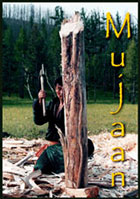
Mujaan (The Craftsman) 2004
Distributed by Green Planet Films, 21 Columbus Ave. Suite 205, San Francisco, CA 94111; 415-377-5471
Produced by Ragcha Media
Directed by Chris McKee
DVD , color, 25 min.
Jr. High - Adult
Anthropology, Asian Studies, Architecture
Date Entered: 05/10/2010
Reviewed by Justin Cronise, University at Buffalo, State University of New YorkMujaan (The Craftsman) is a simple, beautiful, and fascinating film. It is set in rural Mongolia and was made to document the traditional method of crafting a yurt (called “gir” or “ger” in Mongolian) using simple tools and limited resources – essentially just an axe, trees, and sheep. While in reality the film documents a re-enactment of the process practiced for centuries up until recent times, the “Mujaan” character is sincerely portrayed and displays the nomadic ingenuity and artisanship. Mongolian nomads of today still make traditional yurts, but they do use more modern tools.
The film showcases the knowledge and skill of the actor/craftsman, and follows the entire process: cutting down trees for the structure and making a cart to haul the wood (which doubles as the transportation for the finished portable house); shearing sheep and felting the wool into the wall and ceiling coverings; setting it all up, and then finally packing it all up to go. Mujaan is seamlessly interwoven with footage of another artist creating a traditionally-styled painting, which depicts the craftsman at each step of the process to build the yurt. A particularly interesting scene includes the craftsman gently killing a sheep by making a small slit in its belly and reaching in to stop the heart. All of the nutrition and flavor of the blood is retained in the sheep’s body for eating (instead of drained like in most Western cultures), and the hide is used ingeniously in the construction of the yurt. Also, there is an incredible evening scene of several of the men roasting a mongoose by emptying everything out of it and then filling it back up (and binding it closed) with just the meat, spices, water, and heated rocks inside.
The overall understatement and apparent simplicity of the film are among its greatest qualities. It is concise and follows a simple narrative that offers glimpses into traditional Mongolian nomadic culture and living. Notably, there is no narrator, but instead the natural sounds of the craftsman working, and at times it is accompanied discreetly by traditional Mongolian singing and instruments. Additional features include two commentary tracks, one with the filmmaker and an archaeologist, and another with the filmmaker and a film editor. The archaeologist notes in the commentary that the film does not accurately depict gender roles, since one sees the men doing almost all of the work and in reality Mongolian men and women are generally egalitarian and perform the same work. Interestingly, the filmmaker explains that the women were shy about being filmed while doing the work. Other additional features include two short videos of traditional Mongolian singing, one of which features throat singing (it is incredible to watch that sound coming out of the singer, a young man who appears slightly shy and awkward in front of the camera).
Mujaan is itself a finely-crafted film that can be highly recommended, especially in an educational context. This is an excellent film, optimal for classroom viewing, and would be a valuable inclusion in library collections. It would be just as appropriate for introducing young audiences to the diversity of the world’s cultures, as in a college course studying anthropology, and nomadic or indigenous cultures.